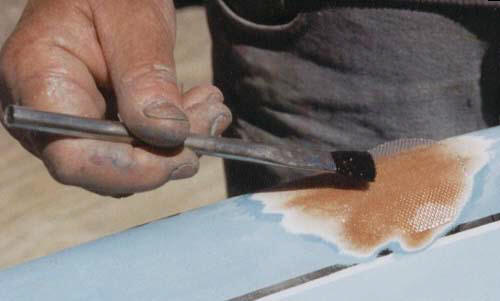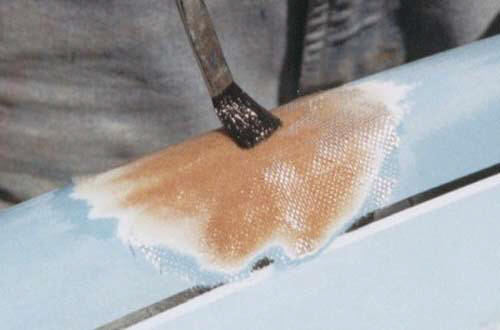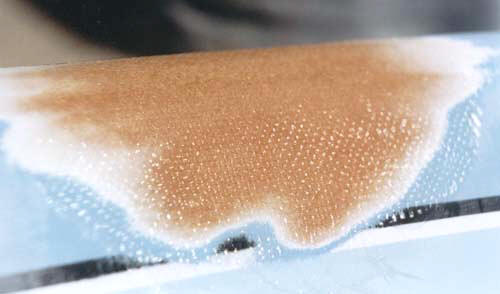|
| |
Fiberglass 101
| The most common
reinforcement in our boards, fiberglass is relatively easily applied well.
Due to the way it is manufactured, though, it is quite vulnerable to sloppy
handling and storage: left unprotected in a moist environment, it will absorb water,
which will interfere with resin absorption. Likewise, greasy hands will
prevent resin absorption. Chunks of debris (sand, wood fibers etc) will
cause bubbles. Once it has been thoroughly wet,
the sizing is rinsed out of fiberglass. No drying will restore this sizing,
so that the material will be useless. Store your fiberglass in Tupperware
containers, or Ziplock bags or such!
Fiberglass cannot bridge gaps gracefully. All deep
gouges, pits and other surface imperfections need to be filled, and the
whole sanded with 60grit paper or similar.
To help the structure it is intended to reinforce, fiberglass needs to remain
firmly attached to it. It won't be, if applied over glossy paint, flaking
resin, crumbly sheet foam, wax, or a film of water. The substrate needs to
be firm, smooth, clean and dry. Here goes: a little rail
scrape came in. All the damaged fiberglass is removed, the site sanded with
60 grit, and all the sanding debris blown off. Two layers of 4oz fiberglass
cloth were involved, so two layers is what I will put back
It is past 4pm, and the temperature has been dropping
for the last 1/2hr. |
 |
Gather the tools (acid brush, scissors,
squeegee),
cut the fiberglass, with the second piece a bit bigger all around then the
first, measure out the Epoxy, and mix exceedingly well ("100 strokes!" my
teacher used to say) |
 |
brush on Epoxy resin
don't pile it on, rather, just apply a "full wet" coat
o, I forgot to tell you: put on gloves, or your hands
end up looking like mine! |
 |
lay the first piece of glass into this
coat of Epoxy. With a moist brush (damp, not loaded), dab at the fiberglass
until it is clear. Brush on a bit more Epoxy. Again, don't pile it on.
Simply brush on enough to make the surface shiny. |
 |
Lay the second piece of glass over the
first, centered nicely. Without dipping the brush again, dab at the
fiberglass. Think of this step as compacting the fiberglass, not of brushing
on resin. |
 |
When the glass has turned clear,
signaling proper resin penetration, swipe at it with a squeegee.
Squish hard enough to push the glass down and wipe
off resin, but just not so hard as to dislocate the fiberglass.
This will
remove air trapped beneath the fiberglass. When air is present, it will make
a distinct "sffft" sound (honest). When all air has been removed, the
lamination is quiet.
|
 |
It is also perfectly transparent. It is
not flooded with resin. Rather, a good lamination has the texture of the
fiberglass standing proud. A good lamination -
one with good resin-to-fiberglass ratio - also does not care about
orientation - right-side-up, upside down - it does not matter. As a matter
of fact, in my boatbuilding days, we routinely used to laminate up to 34oz
of fiberglass overhead in one pass (but I am sure glad I don't have to do
that anymore!) |
|
back to
Repair Menu |
|